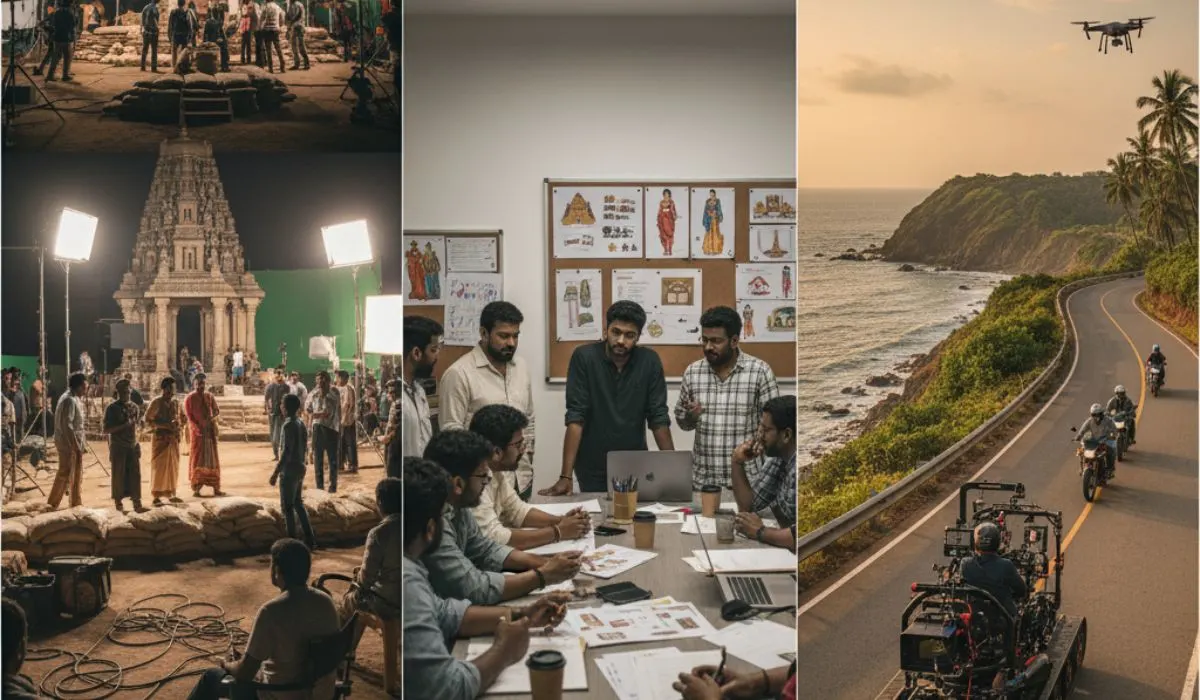You don’t always need a mountain of money to make a movie that moves people. At least not in Kerala. Filmmakers have been secretly creating stories there, tucked away in the alleys of Kochi or the hill settlements of Idukki, that often do what big-budget Bollywood movies cannot touch hearts and turn a profit. In Kerala, filmmaking is a skill based in conscience and culture rather than a competition to surpass others. Unlike the cinematic ecosystems chasing spectacle, Mollywood stays grounded in raw truth. Because sometimes, less truly speaks louder. Welcome to Mollywood where 3 crore can do the magic 300 crore sometimes can’t.
It Doesn’t Take a Fortune to Win an Audience
In most Indian film circles, “success” often means grandeur: massive sets, high paid stars, flashy promotions. But Kerala’s film industry seems to operate on its own wavelength. The greatest successes here frequently come from the least expenditures. Consider Thondimuthalum Driksakshiyum, for one. Just a quiet story. Barely any background score. Shot mostly inside a police station. Budget, Around 3.5 crore. Returns? Over 30 crore.
The Secret Isn’t Just Saving Money, It’s What They Spend On
The point of Mollywood isn't to save money just for the sake of it. Knowing where to invest and where not to is the key. These filmmakers are ruthless in the best way they cut out the unnecessary and go all in on what matters, stories, characters, real emotion.
Take Kumbalangi Nights. That movie was all heart. A slice-of-life tale about four very different brothers trying to hold their messed-up family together. Budget, 6.5 crore. Worldwide collections, Over 38 crore. Furthermore, it didn't require a celebrity to support it. The story did the heavy lifting.
Read also: From Kochi to Cannes: How Malayalam Cinema Quietly Took Over the World
Stars Who Don’t Act Like Stars
One of the most remarkable things about the Malayalam film industry is its people. The actors many of them now known across India are not just faces for hire. They’re collaborators. People like Fahadh Faasil, Suraj Venjaramoodu, Anna Ben, and Nimisha Sajayan regularly sign on for films that might never break 10 crore in budget. Because the screenplay is good, not because the pay is.
The Great Indian Kitchen is a perfect example. It was shot in a home kitchen. No frills. The main actors didn’t wear makeup for most scenes. The lighting, Natural. And yet, the film left viewers shaken. It wasn't shown in theatres initially. It didn’t have to be. It exploded online.
Mollywood Keeps It Local and That’s a Good Thing
You don’t need Europe or Dubai when Kerala itself is a living film set. Backwaters, hills, old colonial homes, narrow lanes, it’s all there. During filming, directors use genuine houses and towns to create their scenes, often using natural light sources. It brings down the cost, sure. But it also gives the scenes a kind of candor that money just cannot purchase. Movies such Maheshinte Prathikaram were filmed in tiny settlements like Idukki and Kumaramangalam. The charm of these settings adds so much to the film and doesn’t cost a bomb.
The Crew Behind the Curtain
Every excellent movie has a team that is underappreciated. In Mollywood, directors frequently collaborate with the same DOP, editor, and sound engineers throughout several films. There is a kind of unspoken beat there. And since everyone knows what they’re doing, the shoots are faster, smoother, and cheaper. A typical shoot wraps up in 30–35 days. Compare that to a Bollywood film that runs for over 100. Less time equals to fewer bills.
No Hype Machine, Just People Talking
Promotion in Mollywood is a different game. No giant billboards or 5 crore PR budgets. These films rely on what matters most the audience. If the movie is good, people will obviously discuss about it . They’ll share clips on WhatsApp, write about it on Facebook, drop Instagram reels. It’s word of mouth, 2025 style.
Jaya Jaya Jaya Jaya Hey didn’t have a blockbuster trailer or big studio backing. But once women saw it, they began spreading the word fast. The movie ended up crossing 45 crore and it started slow. That’s how the industry works. Let the film speak, and people will listen.
Streaming Changed Everything
Let's be honest, OTT is the big deal. Platforms like Netflix, Prime Video, and SonyLIV have opened the floodgates for regional content. And Malayalam cinema, It’s riding the wave like a pro. Earlier, low-budget films struggled to get screen time in theatres. Now, with OTT deals signed even before release, producers recover costs early. Sometimes, before a single ticket is sold. Joji is a case in point. No theatrical release. No delays. Just a quiet debut on Amazon Prime and it reached homes across continents.
Read also: RJ’s Reel Talk: Unfiltered Malayalam Movie Reviews You will Love
Just the Numbers
Let’s look at some real, not exaggerated stats:
|
Movie |
Budget |
Earnings |
|
Kumbalangi Nights |
6.5 Cr |
38+ Cr |
|
Thondimuthalum Driksakshiyum |
3.5 Cr |
30+ Cr |
|
Android Kunjappan V5.25 |
6 Cr |
35+ Cr |
|
Jaya Jaya Jaya Jaya Hey |
6 Cr |
45 Cr |
|
The Great Indian Kitchen |
1.5 Cr |
OTT + Satellite hit |
These aren’t one off miracles. This is the business model.
The Road Ahead Isn’t Bigger, It’s Smarter
What’s exciting is that more young filmmakers are entering Mollywood, ready to tell stories on tight budgets. They’re experimenting wih formats, topics, and storytelling styles that push boundaries. We’re seeing narratives around queer identity, caste, climate change, urban anxiety, and rural decay not from the sidelines but as main plotlines. It’s bold, It’s fresh and guess what? It’s still made on shoestring budgets.
Final Thoughts
Last WordsLook no farther than Kerala if you ever needed evidence that a camera and a great narrative still lie at the core of cinema. This industry is imperfect; it doesn't try to be. What it does have to give, however, is real storytelling, authentic craft, and an audience that values sincerity above showmanship.
Perhaps the lesson is thus. In an age of high stakes and even higher budgets, Mollywood quietly proves that simplicity still sells. As long as the story is honest, the audience will come. Kerala’s film industry doesn’t need explosions to leave an impact, it needs only a moment of silence that hits home. Mollywood is not here to compete; it’s here to create. And it’s showing the rest of the country that cinema doesn’t need to be loud to be legendary. It just needs to be true. Maybe that’s why these small films keep leaving such a big mark.













